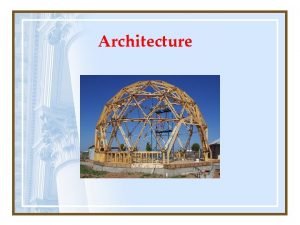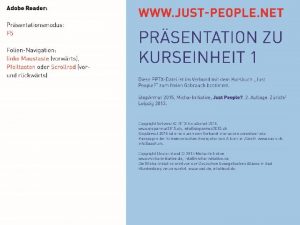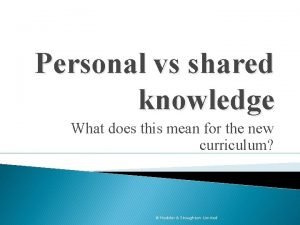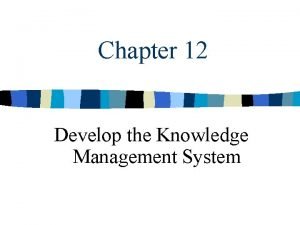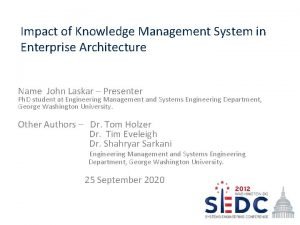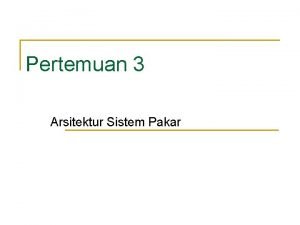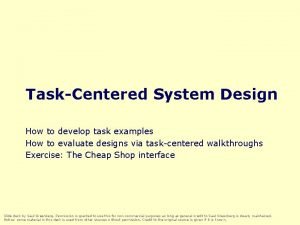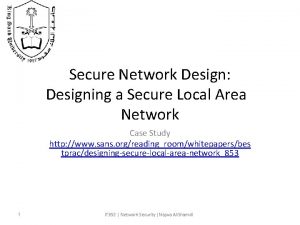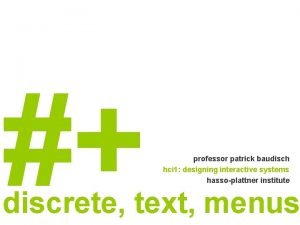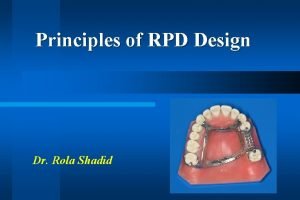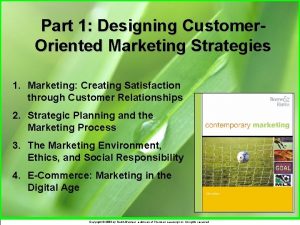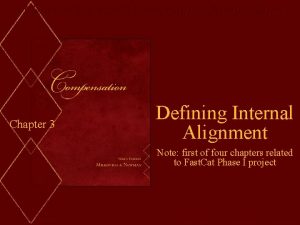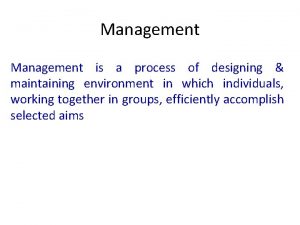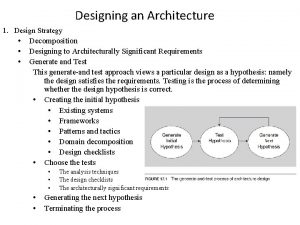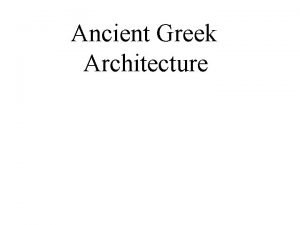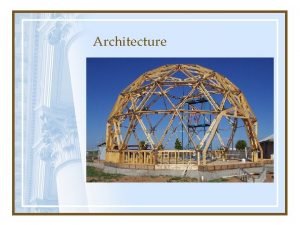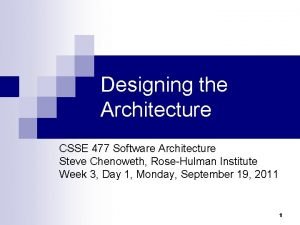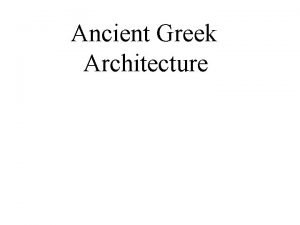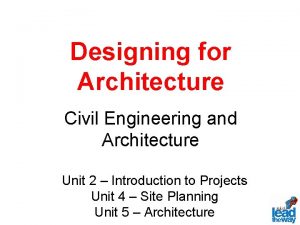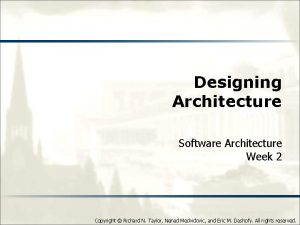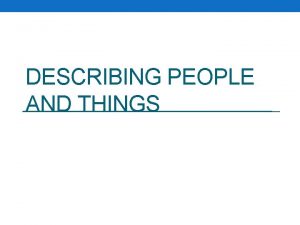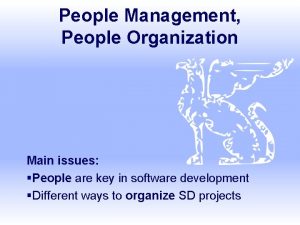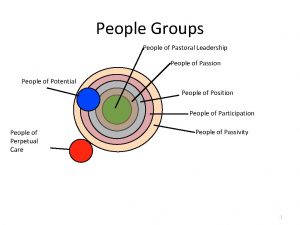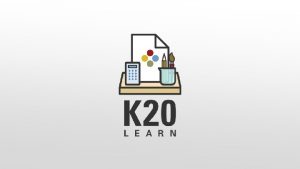Knowledge Architecture People Designing a Knowledge Architecture Department































- Slides: 31

Knowledge Architecture People Designing a Knowledge Architecture Department Tom Reamy Chief Knowledge Architect KAPS Group Knowledge Architecture Professional Services http: //www. kapsgroup. com

Agenda § § § § Introduction: What is Knowledge Architecture? KA Roles and Functions Skills and Backgrounds Tools and Technology Services and Partners Knowledge Architecture Real Life Example Organization and Location of the KA Team 2

Introduction: What is Knowledge Architecture? § The people, processes, and technology of designing, implementing, and applying the intellectual infrastructure of organizations. § What is an intellectual infrastructure? The poor neglected cousin of technology and organizational infrastructures – It is just the set of activities that deal with creating, capturing, organizing, visualizing, presenting, utilizing, understanding, the information part of the information age. – 3

Knowledge Architecture § Information + Contexts = Knowledge § Information Architecture + Infrastructure of Contexts = Knowledge Architecture § Content Contexts – Structured views § Personal / Community Contexts – Personalization, Virtual and real communities § Activity Contexts Knowledge workers and embedded knowledge structures – Smart Applications – 4

Roles and Functions § § § Chief Knowledge Architect Knowledge Analysts Knowledge Engineers Knowledge Facilitators Knowledge Managers Additional Roles: Supplementary and Support 5

Chief Knowledge Architect § Work with Chief Knowledge Officer Build a Knowledge Culture – Advocate, Evangelize – § Design & lead integration of all the elements of the Intellectual infrastructure of the Enterprise § Design measurement and analytics of KM in organization § Define and lead the KA Team § Research New Ideas and Technologies – Personas, Stories, Semantic Web and RDF, Cognitive Anthropology, Complexity Theory 6

Knowledge Analysts § Corporate Librarians + § Content Specialists § Knowledge Organization Structures Taxonomies, Classification Schemas – Metadata and controlled vocabularies – § Search and Categorization Software § Organization of people and activities Tacit Knowledge structures – Living map of communities and information needs – 7

Knowledge Engineers § § § User and task specialist Information Architect+ Collect, analyze, organize tacit knowledge Interview users, focus groups, persona Ethnographic studies Work with Business Analysts 8

Knowledge Facilitators § Establish connections between individuals to facilitate § § knowledge transfer Facilitate explicit knowledge transfer Train people to incorporate KM Understand the information needs of individuals and communities and work with them to achieve business goals. Incorporate KM into chat groups, story telling, email, collaboration and innovation efforts. 9

Knowledge Managers § § § Project Management+ Capture the knowledge generated in a project Develop knowledge sharing practices Capture Best Practices Provide training and leadership on projects Moderate Communities of Practice 10

Additional Roles: Supplementary & Support § Information Architects Develop information navigation systems – Usability, user research – § Web Design User oriented web sites – Prototype IA designs – § Business Analysts, Project managers § E-Learning – Performance Support, Learning Objects 11

Skills: Backgrounds § § § Interdisciplinary, Generalists, Idea and People people Library Science, Information Architecture Anthropology, Cognitive Science Learning, Education, History of Ideas Artificial Intelligence, Linguistics Business Intelligence, Database Administration 12

Tools and Technology: Used by the KA Team § § Categorization, Unstructured Data Management Search Engines Analytics – usage, language and activity Important to use the information tools of the company – Collaboration, ideas databases, content management, etc. § Polls and surveys § Spreadsheets § Brains 13

Knowledge Architecture Partners § IT Applications and System – Implementation and Evaluation § Corporate Communication, HR § Training – Practical projects and theory – Learning Objects § Research Departments 14

Knowledge Architecture Services § Knowledge Architecture Audit § Knowledge Creating Innovation, E-learning – Content Management – • Taxonomic Model, Distributed Categorization § Knowledge Sharing / Transmission – Collaboration, Retrieval – content and experts § Knowledge Using Smart Applications, CRM. Portals – Data warehouse, text mining, business intelligence – 15

Knowledge Architecture Services § Application of Intellectual infrastructure – People – even Amazon is moving away from automated recommendations § Facilitate projects, KM Project teams – Core group of consultants and K managers § Facilitate knowledge capture in meetings § Answering online questions, facilitating online discussions, networking within a community § Design and run forums, education fairs, etc. 16

Knowledge Architecture Services § Infrastructure Activities – Integrate taxonomy across the company • Content, communities, activities Design content repositories, update and adapt categorization – Package knowledge into K objects, combine with stories, learning histories – Metrics and Measurement – analyze and enhance – Knowledge Architecture Audit – Enterprise wide • Project scale • 17

Knowledge Architecture in Real Life: Knowledge Architecture Audit § A set of reports, catalogs, recommendations, and components characterizing the current state of an organization’s intellectual infrastructure. § A foundation and planning document for improving the intellectual health of the organization by incorporating knowledge architecture into a range of projects. § Can be done in a little as two days, five days, or 10 days § And for the rest of your life. 18

Knowledge Architecture in Real Life: Knowledge Architecture Audit § Preliminary Information Gathering – – – CKA – design approach, identify people, work with primary project owners Knowledge Analyst – catalog content repositories, high level characterization, identify content issues Knowledge Engineer – identify representative sets of people to interview and study, select set of approaches Knowledge Facilitator – gather available documentation Knowledge Manager – arrange interviews, meetings 19

Knowledge Architecture in Real Life: Knowledge Architecture Audit § Stakeholder Interviews – CKA, knowledge engineers, business analysts: • executive sponsors, steering committees, content owners, publishers, technical and business support teams, representative user groups, and others. Map the strategic landscape – Map and engage components of the process and procedures of information creation and application – 20

Knowledge Architecture in Real Life: Knowledge Architecture Audit § Content Repository Catalog – – – Knowledge Analyst Structured and unstructured content repositories Source, publishers and authors, procedures – where add structure Metadata, vocabularies, taxonomies, dictionaries (formal and informal – users) Taxonomy and metadata Evaluation 21

Knowledge Architecture in Real Life: Knowledge Architecture Audit § Community Catalog – – – – Knowledge Engineer Formal and informal communities Virtual and Real communities Type – collaboration, communication, etc. Business functions Internal and external communication channels Primary and secondary content repositories 22

Knowledge Architecture in Real Life: Knowledge Architecture Audit § User and Task Analysis Knowledge Engineer, Facilitator – Usability plus information behaviors – Frequency and depth of access • Known item, research, activity • Interviews, focus groups, ethnographic studies – Knowledge Architect – • Search and usage log analysis 23

Knowledge Architecture in Real Life: Knowledge Architecture Audit § Technology Needs Assessment – – – CKA, Knowledge Mangers In partnership with IT and business owners Map infrastructure elements for each technology Evaluation plans and design projects Recommendations and real cost estimates 24

Knowledge Architecture in Real Life: Knowledge Architecture Audit § Practical Foundation & Life After Audit – – – Seed taxonomies and/or controlled vocabularies Metadata schemas, Persona Candidates and methods Project recommendations Prototype screens, applications, web sites Monitor usage and design responses 25

Why Knowledge Architecture? § Knowledge Management Foundation § Immanuel Kant Concepts without percepts are empty – Percepts without concepts are blind – § Knowledge Management KM without applications is empty (Strategy Only) – Applications without KA are blind (IT based KM) – 26

Knowledge Architecture – Sight to the Blind § Search & Retrieval: Is anyone happy? Trends – more articles on taxonomies, CM – New tools and approaches – § Need an infrastructure team of general specialists § Anyone can organize information – card sorts, etc. Web masters to information architects – Develop taxonomies – can’t be done by software or SME’s – Metadata, vocabularies – keywords don’t work – why? – 27

Knowledge Architecture: Taxonomies § Need a combination of formal and informal § Difference between browse and formal taxonomies Hierarchy, lattice, semantic networks, folders, etc. – Important to know the differences – § Quality Metrics Corpus, Coverage, Nomenclature, terminology, dependency – Mixed classes, verbal forms, bad speciation, etc. – Bell Curve, balance of depth and width – § Cognitive Difference – Geography of Thought – Panda, monkey, banana 28

Place in the Enterprise: Intellectual Infrastructure § Would you try to run your company without organizing it? – Or let each project redefine the organization, jobs and pay, reporting structures, etc. ? § Would you try to run your computers without a networked infrastructure? – Or let each person or team have a standalone, own software, own operating system, etc. ? § Why do you think you can run your company without organizing your content in an integrated, systematic way? 29

Organization and Location of the Team § Central, Dedicated Department – Cross Organizational § IT, HR, Corporate Communication, Library, Training § Internal vs. Professional Services § How much can be done at the beginning and then maintained by small staff and how much ongoing? – Answer from Knowledge Architecture Audit 30

Summary § In information age, need to treat information as central § Information organization is an infrastructure element § Knowledge architecture people need to be: Generalists, good with people and ideas – Smart, funny, and can dance real good – § Knowledge architecture will: Bring about the end of history – Usher in the third age of mankind – Help organizations work smarter and cheaper – 31
 Knowledge creation and knowledge architecture
Knowledge creation and knowledge architecture Designing and implementing brand architecture
Designing and implementing brand architecture It is an art and science of erecting structures
It is an art and science of erecting structures Flanker brand strategy
Flanker brand strategy Designing and implementing brand strategies
Designing and implementing brand strategies Examples of people as media and people in media
Examples of people as media and people in media In the usa the big cia
In the usa the big cia Recovery community
Recovery community People just people
People just people Shared knowledge vs personal knowledge
Shared knowledge vs personal knowledge Knowledge shared is knowledge squared
Knowledge shared is knowledge squared Knowledge shared is knowledge multiplied
Knowledge shared is knowledge multiplied Contoh shallow knowledge dan deep knowledge
Contoh shallow knowledge dan deep knowledge Priori
Priori Book smart vs street smart
Book smart vs street smart Knowledge claim
Knowledge claim Gertler econ
Gertler econ Architecture of knowledge based agent
Architecture of knowledge based agent Knowledge management architecture
Knowledge management architecture Knowledge management and enterprise architecture
Knowledge management and enterprise architecture Jelaskan arsitektur sistem pakar
Jelaskan arsitektur sistem pakar Example of task designing
Example of task designing Strategi pesan
Strategi pesan Designing a secure local area network
Designing a secure local area network Patrick is designing a large
Patrick is designing a large Rpa concept in rpd
Rpa concept in rpd Marketing environment framework
Marketing environment framework What shapes internal structures
What shapes internal structures The process of designing and maintaining an environment
The process of designing and maintaining an environment Human resource management defintion
Human resource management defintion Integrated thematic unit
Integrated thematic unit You are designing a sticker to advertise your band
You are designing a sticker to advertise your band


